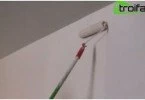How to paint a wooden house outside
The very first house in which a person tried to establish life was a cave. Much later, for the arrangement of their home, people began to use trees that possessed a number of advantages. Wood has low thermal conductivity, retains heat perfectly, and is also able to maintain its performance properties for several decades. Unfortunately, they did not know before that the wooden house needed protection, which is why many cultural monuments could not survive to this day. If people at that time knew how to paint a wooden house, so that it looks good on the outside, and at the same time was reliably protected from various bugs and microorganisms, then they would surely take advantage of the tips that you can read in this article.
Content
- Why does a tree grow old?
- Paint for a new wooden house
- Preliminary stage – thorough preparation
- The better to paint wood?
- How to paint a new wooden surface
Why does a tree grow old?
First, let’s see why wooden houses begin to collapse..
First, you still need to understand that wood is a living material that is prone to aging in any case (after all, a person is also aging). But we, unlike trees, can somehow influence the wilting processes using various medicines, vitamins, creams, etc. Trees cannot do anything like this, and only a person is able to help them prolong their youth.
Secondly, the construction wood is affected by numerous natural factors, such as water, solar radiation and all sorts of small insects, along with mold and fungus. All these natural “cataclysms” (and these minor troubles are really such for the tree) destroy the surface of the wood, as a result of which it becomes coarse, grayer, and its fibers lose their strength and “stand on their hind legs”. These negative phenomena can be noticed literally a few weeks after the new house was built.
Precipitation in the form of rain and snow first causes the wood to swell, and after it dries, a reverse reaction occurs. As a result of this, cracks appear on the surface, inside which the fungus begins to develop, and this small dirty trick can have a different embodiment. So, the blue fungus and mold fungus practically do not have any harmful effect on the structure of the tree, except that the appearance is spoiled. But the rot fungus acts “stealthily” – it develops inside, so it’s quite difficult to notice.
Thirdly, do not discount bark beetles, which can sleep quietly inside your house for 2-3 years, and you will not even suspect such neighbors. But when they wake up, you don’t say hello.
Fourth, atmospheric loads affect wooden buildings located in coastal areas or in open spaces, much more than those houses that are at a decent distance from the source of moisture and which are protected by other houses or forests. In addition, the north side of the building is much less susceptible to negative impacts than the south and west.
As you can see, there are more than enough reasons for aging wood. But you can still help her if you use the right paint.
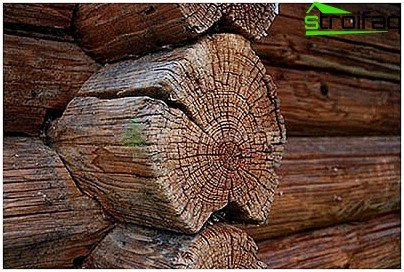
Wood would not have collapsed so thoroughly if protection measures had been taken during the construction process
Paint for a new wooden house
So, you have built a new wooden house and now you want to paint it. But how to paint the house outside? What paint to use for these purposes? Let’s understand.
Preliminary stage – thorough preparation
Before proceeding with staining, it is necessary to carefully prepare the surface of the wood, because this, as mentioned above, is a “living”, breathing material, and not commonplace concrete or brick. It is the preliminary stage that allows you to create the necessary base, due to which the adhesion of the paint to the surface is improved and the durability of the finished coating is significantly increased.
- Using a garden sprayer and a brush that is not too stiff, remove dust and various small impurities from the wood. Water absorbs dust much better than if you just walked with a brush over the entire surface.
- You may notice mold or blue on the tree. In this case, it must be removed with a special tool (by the way, Tikkurila has an excellent drug).
- The resin (if any) must also be removed with a metal spatula, and the place where it was varnished for knots (this will be smoother).
- Various metal parts, such as hats of nails, screws and others, need to be coated with a primer for metal.
- Having completed these works, it is necessary to give the wood a rest for one and a half to two weeks, covering it with a film. Do not forget to leave ventilation openings, and in warm weather you can remove the “blanket” in general.
- If the tree is raw, and it is not possible to dry it, then directly on a damp surface you can apply a tinted primer antiseptic and leave the house alone until there is a chance to dry it.
The better to paint wood?
And yet, what paint to paint a wooden house? For these purposes, you can buy three types of coatings:
- antiseptics
- acrylate paints
- oil paints
Antiseptics have high penetration. The depth of their penetration is 4-7 mm. This allows you to reliably protect the surface of the wood from all atmospheric stresses, mold and rot. They are cover and glaze. Glazing antiseptics are transparent, which means that they not only preserve the texture of the tree, but also give it a noble, natural shade.
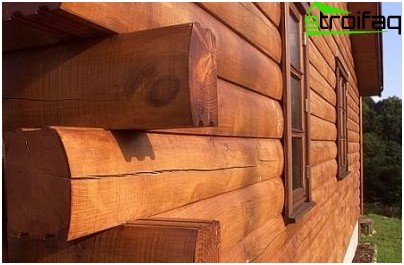
Appearance of wooden beams treated with tinted antiseptic
Opaque antiseptics completely hide the texture of the wood, while maintaining its relief.
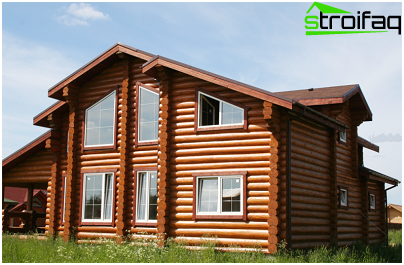
House painted with an opaque antiseptic
Acrylate paints characterized by high weather resistance and retain their color and gloss for a long time. In addition, this paint allows the wood to breathe, which means that your home will be “alive”. The acrylate present in the paint makes it elastic, which allows the paint to “live” in the same rhythm as the house, that is, it does not crack from various kinds of deformations.
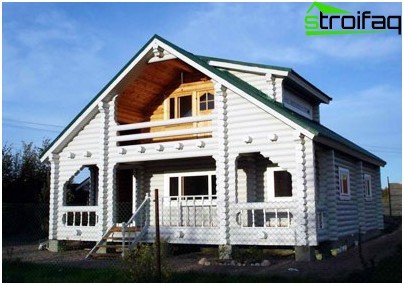
A house painted with acrylic paint that does not interfere with the wood “breathe”
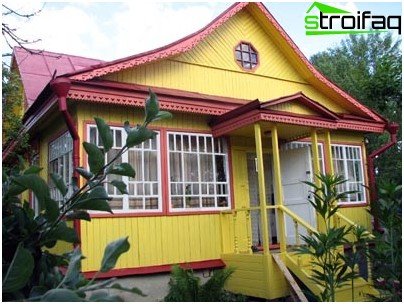
Oil paint protects against atmospheric negativity
Oil paints as well as acrylate ones have excellent weather resistance, and as well as antiseptics, they are perfectly absorbed, but they have one, quite significant drawback – they dry slowly (day or more). In addition, over time, the surface coated with oil paint can change its color and become dull, which, in principle, is not too noticeable on light shades.
Naturally, any, even the most expensive and high-quality paint, sooner or later will require updating. When does this moment come?
- the average life of glazing antiseptics is about 5 years, although this figure can vary both up and down.
- in topical antiseptics – up to 7 years;
- for acrylate paints – up to 10 years;
- in oil paints – up to 6 years.
These figures are, of course, indicative – you yourself must see when your house loses its original appearance.
How to paint a new wooden surface
Special skills for applying paint to wood are not required, but there are still a few nuances that you will have to consider when doing this job.
- Primer application. Priming antiseptic is very important to protect wood from fungi, mold and blue. If you suddenly decide that you can omit this moment and go straight to dyeing, then in two years (or maybe earlier) you will regret it. Do not save on antiseptics, because it can significantly extend the term of the finished coating.
- Application of paint. The first and most important rule is to apply the paint on an absolutely dry surface and in several layers (2-3 layers will be enough). Each layer should be dried..
Rules for applying paint to a wooden surface:
- paint should be mixed periodically so that its shade is always the same;
- it is best to apply paint with a brush, as it is in this way that you can achieve uniform coloring of wood, but do not overdo it with paint;
- for better painting, you can use a color scheme for the primer, then the color will be perfect;
- Do not paint wooden surfaces under the scorching sun – the paint will dry too quickly, which is not desirable. The most favorable weather for painting is warm, cloudy and windless;
- both paint and antiseptic should be applied only in the longitudinal direction;
- the end parts of logs and boards are their weakest link – the water in these places is absorbed very quickly. To avoid rapid destruction and possible rotting due to high humidity, the ends must be carefully treated with several layers of primer and coating material.
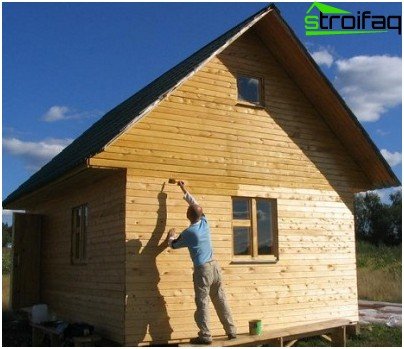
Antiseptic treatment of the facade of a timber house
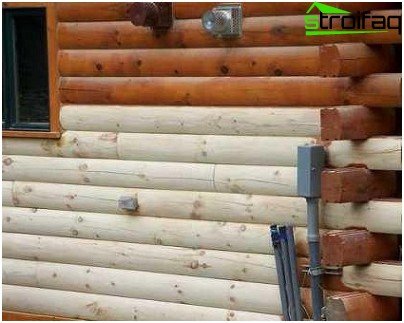
Each element is colored from top to bottom, smudges and “overlaps” are unacceptable
Painting an old wooden house
If your house is no longer new, and you notice mold, peeling paint and other defects on the facade, then you should consider updating the color and giving the house a chance for a new life. Fresh paint will significantly improve not only the appearance of the building, but also allow you to experiment with color.
Before you start painting, you need to carefully examine the surface of your home – maybe something has fallen off somewhere and this something needs immediate repair. In addition, the western and southern parts of the house most often lose their attractive appearance, because it is on these sides that the most negative impacts from the side of mother nature.
Perhaps you will limit yourself to painting only those places that are most “worn out”, or maybe you decide to completely repaint everything and radically change the color.
In case of repainting, you should adhere to the following rule – use either the same paint (meaning the manufacturer), or the same type of paint that you painted last time.
But what if you bought a house and don’t know how it was painted earlier? Then you can try to independently determine the type of paintwork. This is done visually..
- acrylate paint looks and feels like thin skin. Usually it cracks in the direction of the fibers..
- Over time, the oil paint becomes dull and, when touched, can leave a slight chalky mark on the skin. It cracks across the fibers, or cells.
- glaze antiseptics become thinner over time. If its surface is glossy, then you can paint the house with an antiseptic of the same or darker color, or in general with oil paint. And if there are practically no traces of an antiseptic, then you can use acrylate paint.
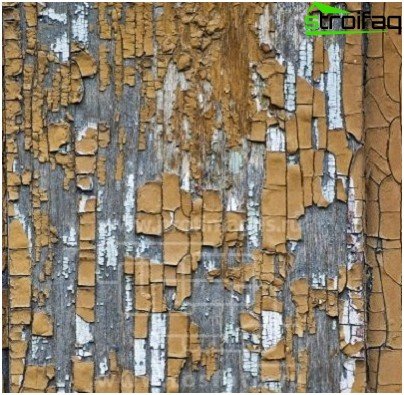
Old peeling paint on a wooden surface – a signal to the start of finishing work
In addition to visual assessment of the surface, you can conduct a small experiment: tear off a piece of old paint and roll it into a roll. If it folds with ease, it means that the house was painted with acrylate paint, and if it crumbled right in your hands, then this is oil paint.
How to paint a house with old paint
So, if you find out (or know) that your house was previously painted with oil paint, then we will update it with the same oil paint, well, or acrylate, just for a start, cleaning the surface of the wood with a metal brush to the base. If the coloring was done with acrylate paint, then we will paint it with it, or (if you really want it too much) with oil paint, but also having previously cleaned the surface of the old paint.
Preparing a wooden facade
First you need to clean the surface of the wood from the hanging pieces of old paint, dirt and dust with a scraper or brush. Then rinse with water, spraying the walls from the spray gun.
If there is mold, then it must be removed with a special solution, and for better adhesion of the paint to the surface of the wood, it can be further treated with an alkaline detergent.
Replace old, uneven and rotten boards with new ones, otherwise they will ruin all the work with their unpresentable appearance.
Paint can be removed with scrapers, metal brushes or chemicals, but if it holds well and does not peel off, then it can be left. By the way, the mechanical method of removing old paint is most preferable if you want to complete all the work as quickly as possible, and if you have a wagon and a small cart, you can use the method of “chemical peeling”. This option preserves the wood texture much better, but takes a lot of time, although the result will certainly please you – the wood surface will be like new.
Additionally, you can carry out grinding, if, of course, this is required.
Next, we follow the same scheme as proposed for new wooden surfaces.
Well, that’s probably all that you need to know for those who are looking for an answer to the question of how to paint a wooden house outside. Adhering to these rules, you can keep your home beautiful and “healthy” for many years..



